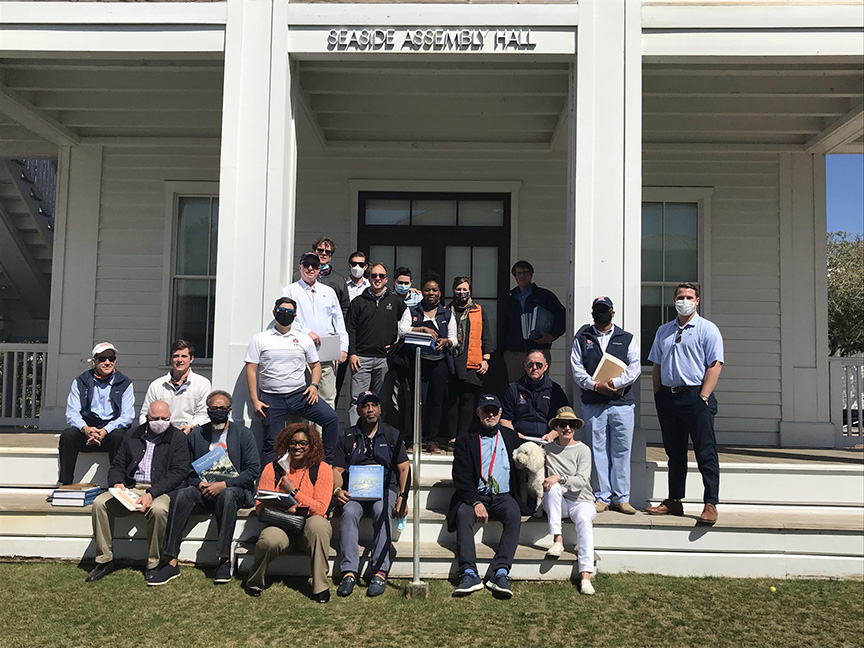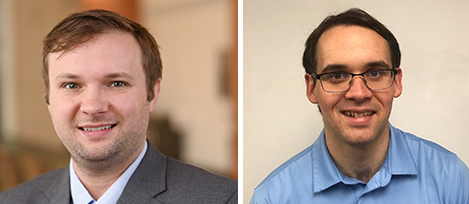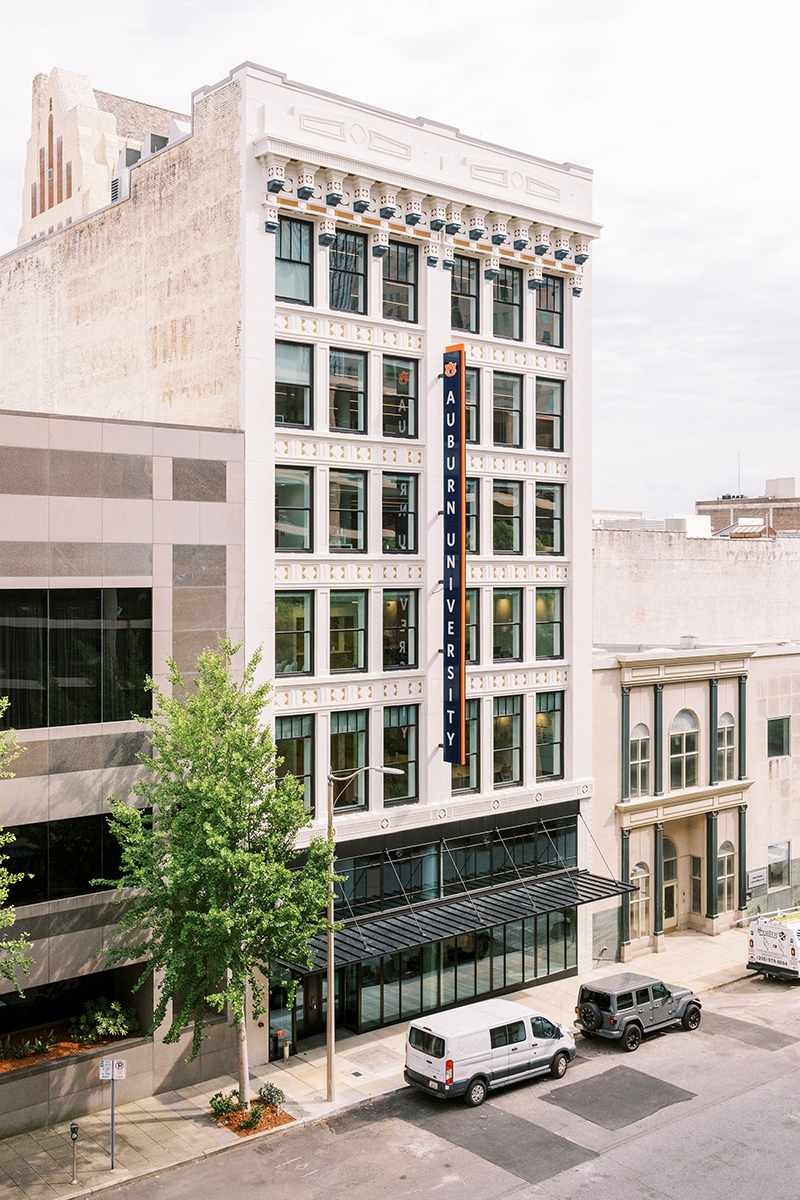
“The Auburn MRED program excels at giving insights into markets where you want to
do business by getting to know the professionals leading the industry on a personal
level.”
— Zac Marquess, Senior Asset Manager, Goldenrod Capital
The Harbert College is dedicated to providing relevant, forward-looking, engaging
curricula, instruction and high-impact experiential learning opportunities.
Fifteen students in Auburn’s Master of Real Estate Development (MRED) Program recently learned from influential developers how to revitalize aging
downtown areas, create luxury beachside communities, and how to manage hundreds of
properties along Florida’s Emerald Coast. The March 8-12 field trip also included
nightly virtual tours of architectural gems and development properties in Melbourne,
Australia.
 “The intent was to let the students meet developers of active projects and hear about
the challenges and opportunities along the way,” said Greg Winchester, Adjunct Professor and Head of Industry and Alumni Relations in Auburn’s MRED Program.
“Students had the opportunity to obtain lessons learned by the developers, discover
best practices, and see cutting edge projects.”
“The intent was to let the students meet developers of active projects and hear about
the challenges and opportunities along the way,” said Greg Winchester, Adjunct Professor and Head of Industry and Alumni Relations in Auburn’s MRED Program.
“Students had the opportunity to obtain lessons learned by the developers, discover
best practices, and see cutting edge projects.”
Offered jointly by the Harbert College of Business and the College of Architecture, Design and Construction, the Auburn MRED program has trained hundreds of industry professionals (contractors,
acquisition officers, realtors, developers, etc.) since its inception in 2010. They
range from contractors who desire a better understanding of the finance side of the
business to professionals from the legal side wanting a better understanding of the
nuances of design and building construction. Auburn students are immersed in the complete
study of the industry, not one specialty.
 |
Zac Marquess, Asset Manager at Goldenrod Capital, MRED student
|
“The Auburn MRED program excels at giving insights into markets where you want to
do business by getting to know the professionals leading the industry on a personal
level,” said Zac Marquess, Senior Asset Manager at Goldenrod Capital and second-year
student in the program. “Not only can you bring ideas back into your own developments,
but new deals are often sparked through conversations with your cohort or Auburn connection.”
The March 8-12 field trip based in Destin, Florida, took students daily to developments
in nearby Seaside, Alys Beach, Pensacola, and Panama City. When the sun set, they
Zoomed to Melbourne, Australia for more architectural, development and cultural explorations.
 |
Michael Simelton, CEO of the Joliet, Illinois, Housing Authority and MRED student.
|
“We had the opportunity to take them out of their day-to-day world to see a much broader
world of real estate and best practices from a variety of situations,” Winchester
added. “The trip also allowed them to understand some of the critical things developers
must deal with. Like one developer said, ‘You’ve got to have location, location, location,
but you also have to have timing, timing, timing correct.’ All of these developers
really wanted to pour their knowledge into the students. But Auburn has such a great
reputation, whether it’s the Harbert College or the CADC, and everybody knows what
Auburn has contributed to real estate over the years.”
Michael Simelton, CEO of the Joliet, Illinois, Housing Authority and second-year Auburn
MRED student, considered the trip “a comprehensive, holistic feel of live, work and
play.”
“We were able to tour projects, and communities that crossed generational boundaries,”
he said. “It becomes multi-generational when you’re able to give customers multiple
experiences, or opportunities, all in the same place. The sites we visited had those
sentiments.”
When Seaside is mentioned along Florida Gulf Coast communities, one often thinks of beachfront
relaxation, the famed 30A, and family relaxation. But this village started as a dream
of developers Robert and Daryl Davis, who bought into the concept of New Urbanism.
MRED students toured Seaside and had the opportunity to interact with the Davises.
“They went all the way back to when Seaside was just an 80-acre tract he had inherited
from his grandfather and how he came up with the idea,” Winchester noted. “They talked
about everything from how hard it was to build and sell the first homes there, mistakes
learned along the way, things they would have done differently, and the different
kind of projects around the world which inspired them.
“Students learned you can take small pieces of land and do something transformative.
Seaside is really a return to what the American community was like before suburbia
emerged post World War II.”
David Everett, President of Alys Beach, along with his team, gave the group a historical presentation on Alys Beach and
a comprehensive site tour.
 |
Alys Beach was considered "Beverly Hills down on Florida's 3oA."
|
“It's a New Urbanism community with a fabulous town center going in and the nicest
beach club I've ever seen,” Winchester lauded. “This is Beverly Hills down on Florida's
30A. Homes in there are easily two million and up, many are north of $5 million, and
some are north of $10 million. These homes are all built to withstand high-level hurricanes.
They're all concrete and rebar construction. The homes are all white -- like something
you would see in Andalusia, Spain. The architecture is very unique, with Moorish and
Mediterranean flair and styles found in Bermuda, Antigua and Guatemala.”
Bob Dickhaus, owner at Dune Vacation Rentals in Santa Rosa Beach, Florida, which manages high-end secondary homes for investor-owned
properties, shared his business ideas and principles with the cohort. “This is luxury
home asset management business we exposed our students to,” Winchester said. “These
owners want to rent out their homes when they aren’t there, have high quality remodeling
work completed, and expect a high level of personal service. This company has nearly
100 homes to manage. Bob, and his wife, Maggie, built this first-class services firm
from the ground up.”
The St. Joe Company hosted the group at its corporate headquarters in Panama City Beach. Dan Velazquez,
Senior Vice President of Commercia Real Estate, and Justin Smith, Vice President of
Development and Construction, gave an overview of St. Joe, its historical and planned
developments, and the future of its major communities and infrastructure along the
Emerald Coast. St. Joe is Florida’s second-largest private landowner with more than
500,000 acres, consisting of timberlands, commercial and real estate developments
and resort communities. Award-winning projects include Watercolor, Watersound and Pier Park, Panama City Beach’s large outdoor mall. Here, students learned about its transformation from a timber
and paper company into a long-term real estate development and investment firm.
 |
Students toured development venues along the Emerald Coast during the day and virtually
met with developers from Melbourne, Australia, each evening during the March 8-12
field trip.
|
MRED Advisory Board member Daryl Bonner toured students through downtown Pensacola, where nearly 40 acres have been cleared for redevelopment on the waterfront. “The
city has issued an RFP for developers to suggest how to build this acreage, some of
which is waterfront. Students saw plenty of opportunities for mixed-use developments.
We met with local developer Andrew Rothfelder, who is advising the city and helping
them run this process. There are a lot of politics involved, which you can imagine.
Much of what the students heard was not only the development options, but politics
and some of the possible ways of financing it.”
Students also toured Pensacola’s East Garden District, where a long-term, mixed-use urban revitalization project will have adaptive reuse
of existing office buildings, along with a new hotel and retail. Chad Henderson, Founder
& CEO of Catalyst Health Care Real Estate, the developer of this project, discussed both this deal and his medical healthcare
business.
“This taught them about what we call place making, which is where you're not just
building another strip-shopping center or small office building,” Winchester said.
“You're trying to create a place that your customer, which are your tenants or the
people that are shopping there or working there, want to come to. You're creating
a sense of place, particularly when you're dealing with these mixed-use projects.”
Students not only toured high-end developments, but also learned about developments
to help working families and financing hurdles for construction. Parkside Equities, an Atlanta-based developer, utilizes federal loans that cover both the construction
and post-construction periods, in order to create rental properties for markets that
have endured difficult times acquiring financing for apartments.
Lenny Metz, Principal with Parkside, gave the story of the development of Parkside at the Beach Apartments and adjacent retail parcels in Panama City Beach.
“Students met the development team, heard about the project, what it was like landing
FHA financing, and toured the property,” Winchester said. “In the middle of building
this community, a hurricane (Michael) came through and barely missed these apartments,
thank goodness. Because of that, there was a severe housing shortage down there. When
these apartments were finished, they were 100 percent leased and occupied the day
of completion, which never happens in an apartment. These people lost their homes,
needed a place to live, and Parkside was there to serve them.”
Though morning and afternoon sessions toured live developments along the coast, students
were treated to virtual lessons from Australia in the evening. Lessons included:
- Virtual walkthrough of Melbourne
- Meetings with representatives from Charter Hall, the developer of Melbourne’s CBD landmark Wesley Place and Zoom session with representatives from Melbourne developer Lendlease
- Virtual tours of the Great Ocean Road, innovative multi-use developments of Melbourne Connect and Melbourne Quarter
- Virtual tours of other significant buildings, developments and historical venues
“One of the greatest parts that I take away from these trips, real or virtual, is
that students were able to ask many questions to these developers and interact with
them,” Winchester said. “Students saw first-class developments, learned from mistakes
that were made and got a first-hand account of how developers overcame challenges
along the way. Those are big takeaways for them – lessons they can use later in their
careers.”
Simelton said Auburn’s MRED education, through coursework and field visits, are helping
him serve better as the leader of a non-profit, affordable housing agency. “It makes
for easier conversations with stakeholders and the residents that I serve,” he said.
“We’re talking about ideas and you can see their heads begin to nod. You’re not just
haphazardly building bricks and sticks. Through the Auburn MRED program, you’re reimagining
the whole design concept.”
 |
Greg Winchester (left), Auburn MRED Adjunct Professor and Head of Industry and Alumni
Relations, and Michael Robinson (right), Director of the Graduate Program in Real
Estate Development, meet with Seaside founder Robert Davis, who transformed an 80-acre
tract along the Florida Gulf Coast into a vacation destination.
|


 Degrees & Programs
Degrees & Programs
 Faculty & Staff
Faculty & Staff
 Career Development
Career Development
 Recruiters & Industry
Recruiters & Industry

 “The intent was to let the students meet developers of active projects and hear about
the challenges and opportunities along the way,” said
“The intent was to let the students meet developers of active projects and hear about
the challenges and opportunities along the way,” said 








